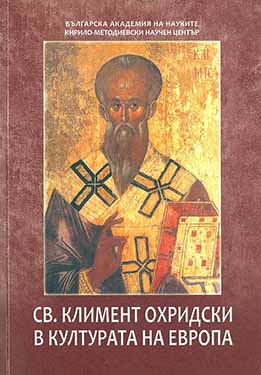Какъв текст държи св. Климент Охридски?Изображенията на св. Климент с разтворен свитък и Евангелие
What Text is St. Clement Holding? The Images of St. Clement with Open Scroll and Open Gospel Book
Author(s): Ralitsa Russeva
Subject(s): Language studies, Language and Literature Studies, Fine Arts / Performing Arts, Visual Arts
Published by: Кирило-Методиевски научен център при Българска академия на науките
Summary/Abstract: The images of St Clement holding open scroll or open Gospel Book are rare in the church art and one can find them sporadically through different periods. The first-group images are of St. Clement as a figure of the Melismos composition, on his scroll are written pericopes of the Divine Liturgy: St. George Church in Staro Nagorichane (1316–1318); St. Demetrius Church in Markov Monastery (1376/77) near Skopje; Cave Church The Nativity of Holy Virgin (16th c.) in the Monastery Kalishta near Struga. On the artophorion from the Monastery of St. Nahum near Ohrid (1833; NHM Sofia № 29114), St. Clement is a figure of the Melismos composition again, but on his scroll is written: „Κλήμης το κλήμα της αληθούς αμπέλου“ – this is the beginning of the troparion from the Office of St. Clement by Theophilact of Ohrid. The only image of St Clement as a monk is from the second floor of the nartex (1345) of St. Sofia Church in Ohrid. He is depicted there as last figure from the large Donor’s composition, holding a scroll with a written text of more than ten lines, but the fresco is in bad condition. The second-group images are of St Clement holding an open Evangelion (Gospel Book)with a pericope from the Gospel of Matthew (6:14): the engraving in the Christophor Zhefarovic’s Stematography (1741); the icon of St. Clement (1779) from the Church of Holy Virgin Peribleptos; descriptions in two Hermeneias of Dicho Zograph (1844 and 1851), and an icon by him – The Holy Virgin and Saints (1844) – from the Church of St. John Kaneo in Ohrid. In the realm of conjecture remains an image of St. Clement which actually existed earlier and inspired the writing of these verses, in the later works mentioned above. The verses from the Gospel of Matthew (6:14–21) are to be read on Quadragesima Sunday. St. Clement’s Homily speech for Quadragesima Sunday, according to the text by St John Chrysostom, is only known from Russian copies, among which the earliest date back to the 14th–15th century and their authorship in science is debatable. On the icon (end of 18th c.) from the Church of St. George in Struga, St Clement is depicted holding an open Book with pericopes from the Gospel of Matthew (5:14, 16). This text cannot be considered arbitrary: the Gospel of Matthew (5:14–19) will be read on the Sunday of the Fathers of the First Six Ecumenical Councils. We can therefore summarize that the images of St. Clement in the Melismos composition emphasize his role as Head of the Ohrid church and first pontiff predicating in Slavic language; those where the saint is holding an open Gospel Book convey his mission as Equal of the Apostles; and the image of St. Clement as a monk recalls his ascetic exploit and his angelic way of life. The texts themselves can be discerned as Liturgical, Evangelical-didactical, and hymnography. The selection of certain verses in some examples can be arbitrary, but others evidence thorough knowledge of St. Clement’s teachings and of the works dedicated to him.
Book: Свети Климент Охридски в културата на Европа
- Page Range: 751-766
- Page Count: 16
- Publication Year: 2018
- Language: Bulgarian
- Content File-PDF

